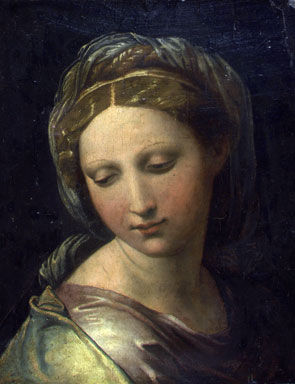Painting in Storage at Italian Ducal Palace May Be Raphael's
A view of a portrait which Italian art experts now believe to have been created by Renaissance genius Raphael in Florence, Italy, 07 May 2010. The painting had lain in storage in a ducal palace since the 1970s. At the time, experts said it was probably a 17th-century copy of a painting from the Raphael School. But Mario Scalini, an arts assessor, thinks it is actually an early version of a famous painting, the Madonna of the Pearl, which is held by the Prado Gallery in Madrid. EPA/STR.
ROME (AP).- A finely painted portrait of a demurely looking woman nestled in an exceptionally ornate frame that was kept in an Italian ducal palace storeroom appears to be a Raphael original and not a copy as long thought, an art official in central Italy said Friday.
However, experts on the Renaissance giant quickly cautioned that art historians would have to closely study it before any conclusions can be made.
Mario Scalini, state superintendent for art in Modena and nearby towns, said he was doing an inventory of about 20,000 paintings in storerooms after he was named to the post a few years ago when he was struck by an unusually fancy, gilded 17th century frame in the palace in Sassuolo, near Modena.
It surrounded a portrait of a lady, hair braided, head tilted to one side and eyes demurely looking downward, as if the portrait-sitter wanted to avoid the gaze of the artist.
The work was long considered to be a copy of the head of one of the subjects in the much larger "Madonna della Perla" (Madonna of the Pearl) in Madrid's Prado museum, Scalini said.
The Prado work is considered to have been painted by Giulio Romano from a design of Raphael not long before he died 1520.
But Scalini said in a telephone interview that he wondered why a copy would be given such an elaborate frame. He said a hunch that it might be a Raphael was heightened when he found centuries-old inventory notations indicating the collection contained a woman's portrait by Raphael.
The documentation contained no indication the Raphael work might have been later sold or otherwise transferred, he said. "It had obviously been forgotten" and sat in the storeroom for decades, Scalini said.
The art official sent the 12 by 16 inch (30 centimeter by 40 centimeter) work to a laboratory in Florence, where one of the experts who ran scientific tests on the painting, Anna Pelagotti, said infrared testing revealed three layers underneath, including a preparatory design.
"It was a beautiful sensation, our mouths dropped open," said Pelagotti, describing the reaction she and her fellow experts had when the saw the sketch. "It looked more Raphael" than one could imagine, Pelagotti marveled, adding, "you could see his hand" in the finely detailed sketch.
Scalini said he hopes during a visit to Madrid later this month on other business that he can persuade the Prado to lend "Madonna della Perla," so art historians can study the two works side by side to help conclude if the long languishing painting is really Raphael's.
The Vatican Museums are home to one of the world's finest collections of Raphael paintings, and the Museums' director of painting restoration, Maurizio De Luca, who worked on the Raphael Stanzas frescoes, stressed that such lab tests cannot attribute with certainty who painted the portrait.
"They can't say it's Raphael's. That will come" only after study by art critics and historians who will decide if it was painted by the artist or perhaps one of his pupils, De Luca said by phone.
At Scalini's request, no "invasive" testing, such as analyzing bits of paint were done, to avoid damaging the painting, Pelagotti said.
But De Luca stressed that while chemical or other scientific analysis can determine if the material came from a certain time period, "you always need face-to-face examination" by art scholars to reach on judgment on the artist's identity. By: Frances D'Emilio, Associated Press Writer. Copyright 2010 The Associated Press.
A view of a portrait which Italian art experts now believe to have been created by Renaissance genius Raphael in Florence, Italy, 07 May 2010. The painting had lain in storage in a ducal palace since the 1970s. At the time, experts said it was probably a 17th-century copy of a painting from the Raphael School. But Mario Scalini, an arts assessor, thinks it is actually an early version of a famous painting, the Madonna of the Pearl, which is held by the Prado Gallery in Madrid. EPA/STR. ROME (AP) — Un tableau d'une femme de 30 cm sur 40 cm, qui était entreposé dans un palais près de Modène en Emilie-Romagne, pourrait être en réalité une oeuvre de Raphaël (Raffaello) et non une imitation, a annoncé vendredi un responsable du ministère de la culture italien. Mario Scalini, intendant du ministère de la culture de la région de Modène, procède depuis quelques années à un inventaire des 20.000 oeuvres dont il a la charge. Il a découvert un cadre datant du 17e siècle, fastueusement décoré dans un palais à Sassuolo. L'oeuvre était répertoriée comme une imitation d'un fragment du tableau plus grand intitulé la "Madonna della perla", qui se trouve aujourd'hui à Madrid au Prado, oeuvre de Guilio Romano inspirée d'un dessin de Raphaël et réalisée peut avant la mort du célèbre peintre italien en 1520. Mais comment une simple imitation d'un fragment d'une oeuvre pouvait être encadrée avec tant d'opulence? "A mon sens, il a été simplement oublié" a confié Mario Scalini, qui est sûr que cette femme d'apparence timide a bien été peinte par Raphaël. La tableau a été envoyé à un laboratoire à Florence, où les experts devront déterminer si le tableau est bien une oeuvre du maître du Rinascimento. AP Raffael„ "La Perla“. Madrid, Prado, Inv. 301. Pappelholz, 144 x 115 cm

/https%3A%2F%2Fprofilepics.canalblog.com%2Fprofilepics%2F1%2F0%2F100183.jpg)
/https%3A%2F%2Fstorage.canalblog.com%2F03%2F02%2F119589%2F96711876_o.jpg)
/https%3A%2F%2Fstorage.canalblog.com%2F11%2F31%2F119589%2F94773502_o.jpg)
/https%3A%2F%2Fstorage.canalblog.com%2F20%2F83%2F119589%2F94772815_o.jpg)
/https%3A%2F%2Fstorage.canalblog.com%2F26%2F72%2F119589%2F75604929_o.jpg)
/https%3A%2F%2Fstorage.canalblog.com%2F59%2F60%2F119589%2F26458628_o.jpg)





/http%3A%2F%2Fstorage.canalblog.com%2F23%2F48%2F119589%2F122509465_o.jpg)
/http%3A%2F%2Fstorage.canalblog.com%2F19%2F64%2F119589%2F121786201_o.jpg)
/http%3A%2F%2Fstorage.canalblog.com%2F94%2F05%2F119589%2F117582005_o.jpg)
/http%3A%2F%2Fstorage.canalblog.com%2F07%2F41%2F119589%2F112792921_o.jpg)